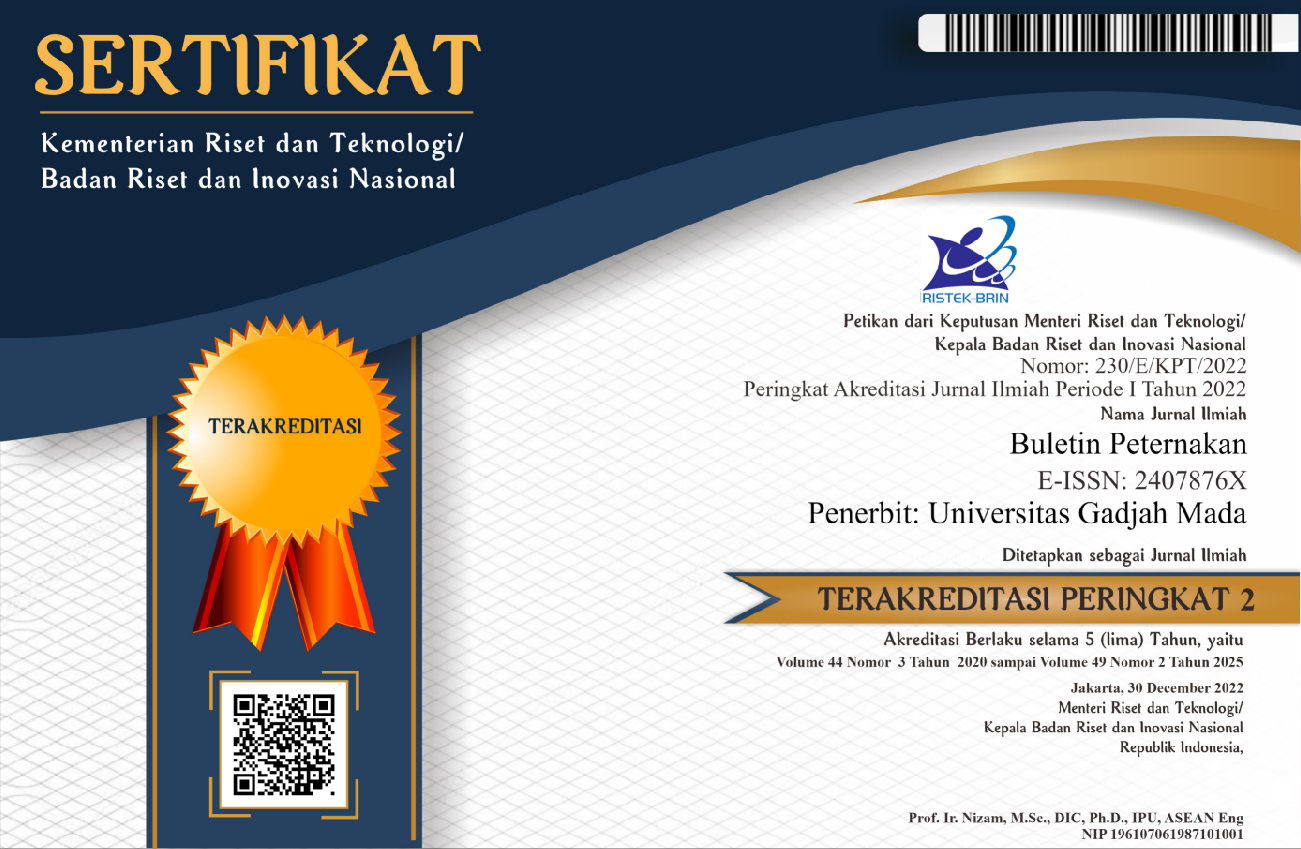Study of Animal-Based Food Product Labeling use
Candra Pungki Wibowo(1), Suci Paramitasari Syahlani(2*), Sudi Nurtini(3)
(1) Faculty of Animal Science, Universitas Gadjah Mada, Yogyakarta 55281, Indonesia
(2) Faculty of Animal Science, Universitas Gadjah Mada, Yogyakarta 55281, Indonesia
(3) Faculty of Animal Science, Universitas Gadjah Mada, Yogyakarta 55281, Indonesia
(*) Corresponding Author
Abstract
Keywords
Full Text:
PDFReferences
Al-Khamees, N. A. 2018. Attitudes towards and use of nutrition labels by Kuwait University students. College Student Journal. 52: 215-226.
Aygen, F. G. 2012. Determinants of nutrition label use among turkish consumers. Int. J. Humanities Soc. Sci. 7: 53-70.
Darkwa, S. and P. C. Affram. 2013. Consumers' knowledge, understanding and use of food label information, and how it affects purchasing decision in ho, ghana. Asian J. Empirical Research. 5: 24-39.
Drichoutis, A. C., P. Lazaridis, R. M. Jr. Nayga, M. Kapsokefalou and G. Chryssochoidis. 2008. A theoretical and empirical investigation of nutritional label use. Eur. J. Health Econ.9: 293-304.
Edem, M. A., M. K. A. Simon, and D. A. Evelyn. 2013. Exploring consumer knowledge and usage of label information in homunicipality of ghana. Eur. Scientific J. 28: 297-311.
Gonzalez-Roa, M. C. and R. Calatrava. 2008. Food Labeling Use and Differentiated Consumers Behavior: A survey Analysis in Spanish Food Market. http://ageconsearch.umn.edu/bitstream/43541/2/097.pdf. Accessed 18rd Jan 2016.
Jacobs, S. A., H. de Beer, and M. Larney. 2010. Adult consumers’ understanding and use of information on food labels: a study among consumers living in the Potchefstroom and Klerksdorp regions, South Africa. Public Health Nutr. 14: 510-522.
Jeddi, N. and I. Zaiem. 2010. The Impact of Label Perception on the Consumer’s Purchase an Application on Food Product. IBIMA Business Review. 2010:1-14.
Magistris, T. D., A. Gracia, and J. B. Hurle. 2010. Effects of the nutritional labels use on healthy eating habits in Spain. J. Agric Econ. 56: 540-551.
Misra, R. 2007. Knowledge, Attitudes, and Label Use among College Students. J. Am. Diet. Assoc. 107: 2130-4.
Osei, M. J., D. R. Lawer and R. Aido. 2012. Consumers’ use and understanding of food label information and effect on their purchasing decision in Ghana: A case study of Kumasi Metropolis. Asian J. Agricult. Rural Develop. 2: 351-365.
Kotler, P. and K. L. Keller. 2014. Marketing Management, 14th edn. Pearson, Boston.
Peter, J. P. And J. C. Olson. 2008. Consumer Behavior and Marketing Strategy. 8th edn. Mc-Graw-Hill International Editions. Singapore.
Petrovici, D., A. Fearne, R. M. Jr. Nayga and D. Drolias. 2012. Nutritional knowledge, nutritional labels, and health claims on food. Br. Food J. 144: 768-783.
Rekha, B. 2015. Knowledge, attitude and frequency of reading food labels of males and females in Mumbai city. J. Sai Om Sci.. 194: 245-252.
Signal, L., T. Lanumata, J. A. Robinson, A. Tavila, J. Wilton and C. N. Mhurchu. 2008. Perceptions of New Zealand nutrition labels by Ma¯ori, Pacific and low-income shoppers. Public Health. Nutr. 11: 706-713.
Talagala, I. A. and C. Arambepola. 2016. Use of food labels by adolescents to make healthier choices on snacks: a cross-sectional study from Sri Lanka. BMC Public Health. 16((739): 1-11.
Zheng, S., P. Xu and Z. Wang. 2011. Are nutrition labels useful for the purchase a familiar food? Evidence from Chinese consumers’purchase of rice. Front. Bus. Res. China. 5: 402-421.
Zorba, N. N. and M. Kaptan. 2011. Consumer food safety perceptions and practices in a Turkish community. J. Food Protection 74: 1922-1929.
Article Metrics
Refbacks
- There are currently no refbacks.

This work is licensed under a Creative Commons Attribution-ShareAlike 4.0 International License.
Buletin Peternakan (Bulletin of Animal Science) Indexed by:

This work is licensed under a Creative Commons Attribution-ShareAlike 4.0 International License.









